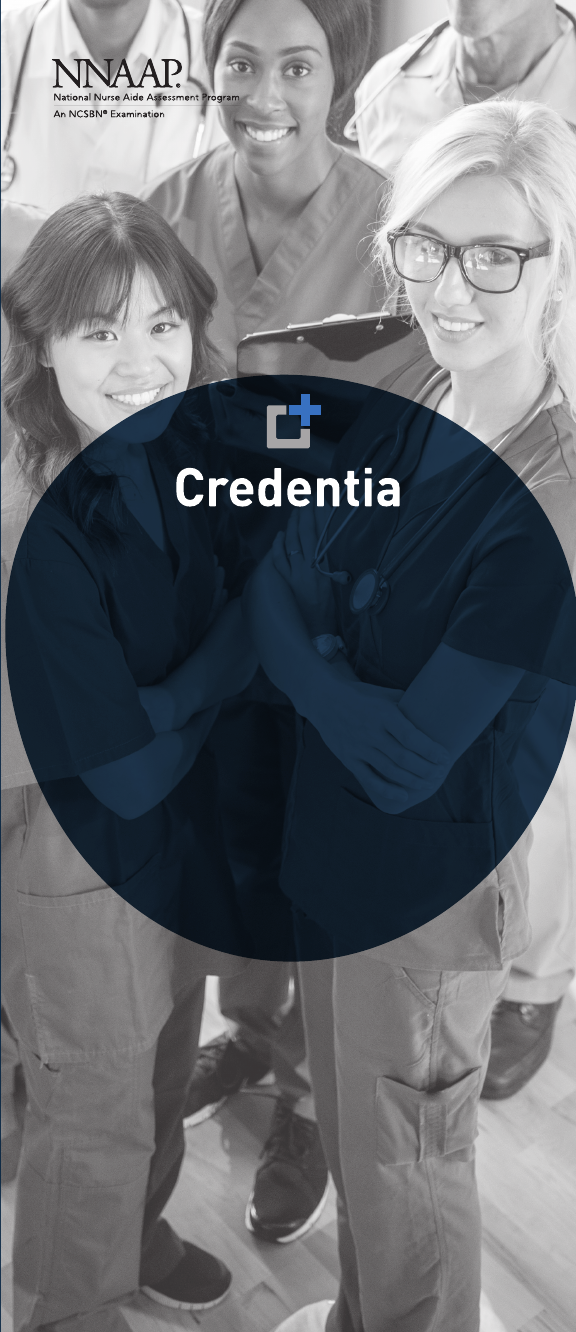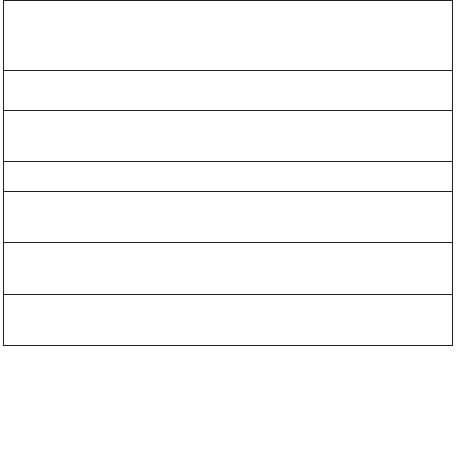
January 2022
verPANA2.0
Pennsylvania
NURSE AIDE
written (or oral) examination
& skills evaluation
Candidate Handbook

QUICK REFERENCE
CREDENTIA REGISTRATION AND SCHEDULING
SERVICES
Pennsylvania NNAAP
(800) 457-6752
Hours of Operation
Mon – Fri 8:00 a.m. – 11:00 p.m.
Sat 8:00 a.m. – 5:00 p.m.
Sun 10:00 a.m. – 4:00 p.m.
(Eastern Time Zone)
Call Customer Service to:
• Check exam scheduling date and/or status
• Find test sites and availability
• Schedule, reschedule or cancel an examination
• Ask questions about online registration
• Obtain information regarding your Score report
• Obtain information regarding your examination
Go to Credentia’s website at
www.credentia.com/test-takers/pa to:
• To view most current exam updates
• Download a Candidate Handbook
• Download a Registration Application
• Download a Reciprocity Application
• View the Nurse Aide Practice Written Examination
• Submit a change of name or address
• Verify your status on the Registry
AFTER THE EXAM DATE
1 (800) 852-0518
Call for questions about:
• Name and address changes AFTER being placed
on the Pennsylvania registry
• The exam content
Hours of Operation
Mon – Fri 8:00 a.m. – 5:00 p.m.
(Eastern Time Zone)

CREDENTIA SERVICES REGISTRY MANAGEMENT
Managed by Credentia
PO Box 13785
Philadelphia, PA 19101-3785
(800) 852-0518
Hours of Operation 8:00 a.m. – 5:00 p.m.
(Eastern Time Zone)
Call to:
• Order Candidate Handbooks
• Clarify information about the Registry
• Change your current address or name once you are
on the Registry
• Obtain instructions to change your name or social
security number once you are on the registry
• Obtain information regarding reciprocity
• Obtain information on continued enrollment on the
Registry
• Obtain a Test Registration Form
PENNSYLVANIA DEPARTMENT OF HEALTH
(DIVISION OF NURSING CARE FACILITIES)
(717) 787-1816
Hours of Operation 8:00 a.m. – 4:30 p.m.
(Eastern Time Zone)
The Pennsylvania Department of Health
administers the Commonwealth contract to
provide nurse aide registry services.
Call the Pennsylvania Department of Health to:
• Inquire about the annotation of nurse aide
registrations

PENNSYLVANIA DEPARTMENT OF EDUCATION
Bureau of Career and Technical Education
333 Market Street
11th Floor
Harrisburg, PA 17126-0333
ra-natcep@pa.gov
Hours of Operation 7:30 a.m. – 4:00 p.m.
(Eastern Time Zone)
The Pennsylvania Department of Education approves
Pennsylvania nurse aide training programs.
Visit the Pennsylvania Department of Education at
www.education.state.pa.us/nurseaide for:
• General information regarding nurse aide training
requirements
• A list of state-approved nurse aide training
programs
PENNSYLVANIA
DEPARTMENT OF HUMAN SERVICES
Office of Long-Term Living
Bureau of Fee For Service Programs
6th Floor, Forum Place Building
555 Walnut Street
Harrisburg, PA 17101
(800) 932-0939, option 1
Hours of Operation 9:00 a.m. – 12:00 p.m.
and 1:00 p.m. – 4:00 p.m.
(Eastern Time Zone)
Call the Department of Human Services to:
• Obtain information/assistance regarding federal
regulations for reimbursement from Nursing
Facilities to employed nurse aides
• Acquire help with any discrepancies in eligibility
for reimbursement
• For issues with testing or test reports,
email: ra-pwnurseaide@pa.gov

DOH and Credentia do not discriminate on the basis of age, sex, race, creed,
disabling condition, religion, national origin, or any other protected characteristics.
Copyright © 2021 Credentia Services LLC, or its aliate(s). All Rights Reserved.
NNAAP® Written Exam Content Outline and Practical Skills Listing
Copyright © 2020 National Council of State Boards of Nursing, Inc. (NCSBN®). All rights reserved.

TABLE OF CONTENTS
Quick Reference ........................... inside front cover
Introduction ........................................................ 1
National Nurse Aide Assessment Program ............... 1
Exam Overview ........................................................ 1
Eligibility .................................................................. 2
Eligibility by Examination ........................................ 2
Registration and Scheduling ........................... 3
Online Registration and Scheduling ......................... 3
Exam Fees ................................................................. 4
Reimbursement for Training and Testing ................. 5
Exam Scheduling ...................................................... 5
Accommodations ...................................................... 6
Light Duty ................................................................ 6
Cancellation & RESCHEDULING .......................... 7
Refunds .................................................................... 7
Absence Policy .......................................................... 7
Weather Emergencies ................................................ 8
Exam Day (ONLINE EXAM) ...................................... 8
What You'll Need ..................................................... 8
Before Exam Day ...................................................... 8
On Exam Day .......................................................... 9
Exam Day (Test Center EXAM) ........................... 10
Checking In ............................................................. 10
What to Bring ......................................................... 11
Proper Identification ................................................ 11
Security and Cheating ............................................. 11
Testing Policies ........................................................ 12
Lateness ............................................................... 12
Electronic Devices ............................................... 12
Study Aids ........................................................... 12
Eating/Drinking/Smoking ................................... 12
Misconduct .......................................................... 12
Guests/Visitors ..................................................... 12
The Written (or oral) Exam ............................ 13
Written Exam .......................................................... 13
Oral Exam ............................................................... 13
Self-Assessment Reading Test .................................. 13
continued on next page

Written (or Oral) Exam
Content Outline ............................................. 14
Sample Questions ................................................ 15
Self-Assessment reading test ........................... 16
Part 1: Vocabulary ................................................... 16
Part 2: Comprehension ............................................ 18
The Skills Evaluation ......................................... 20
What to Expect ...................................................... 20
Setting ................................................................ 20
Who Will Act as a Client? .................................. 20
Candidate Volunteer Requirements ..................... 21
The Tasks ................................................................ 21
Recording a Measurement ...................................... 22
Sample Recording Sheet
for Measurement Skills ....................................... 23
Tips for the Skills Evaluation ............................. . 24
Skills Listing .................................................... 25-40
Score Reporting .................................................. 41
Exam Results ........................................................... 41
Score Reporting ................................................... 41
Failing ...................................................................... 41
How to Read a Failing Score Report ...................... 42
Passing .................................................................... 43
grievance process ............................................... 44
The Registry ........................................................... 44
Registry Renewal .................................................... 44
CNA365 .................................................................. 45
Change of Address or Name .................................... 45
Lost Registry Cards ................................................ 46
Re-activating Inactive Status .................................. 46
Reciprocity ............................................................... 47
PA nurse aide Registry —
frequently asked questions .................. 48-55
DUPlicate Regristry CarD Request...............56-57

1
INTRODUCTION
is handbook is designed for candidates seeking enroll-
ment on the Pennsylvania Nurse Aide Registry. It describes
the process of applying for the National Nurse Aide
Assessment Program (NNAAP®) and taking the NNAAP®
Examination. It should be kept for future reference.
e Pennsylvania Department of Health has contracted
with Credentia, a nationally recognized leading provider
of assessment services to regulatory agencies and national
associations, to develop, score, and report the results of the
competency examination for the Pennsylvania Nurse Aide
Registry. Credentia also processes applications, schedules
examinations, and administers the examinations.
NATIONAL NURSE AIDE ASSESSMENT
PROGRAM (NNAAP®)
e Nursing Home Reform Act, adopted by Congress as
part of the Omnibus Budget Reconciliation Act of 1987
(OBRA ’87), was designed to improve the quality of care
in long-term health care facilities and to dene training
and evaluation standards for nurse aides who work in such
facilities. Each state is responsible for following the terms
of this federal law.
e National Nurse Aide Assessment Program (NNAAP®)
is an examination program designed to determine minimal
competency to become a licensed nurse aide in your state.
e NNAAP was developed by the National Council of
State Boards of Nursing, Inc., (NCSBN) to meet the nurse
aide evaluation requirement of federal and state laws and
regulations. Credentia is the authorized administrator of the
NNAAP in your state.
e NNAAP Examination is an evaluation of nurse
aide-related knowledge, skills, and abilities. e NNAAP
Examination is made up of both a Written (or Oral)
Examination and a Skills Evaluation. e purpose of the
NNAAP Examination is to test that you understand and
can safely perform the job of an entry-level nurse aide.
EXAM OVERVIEW
e two parts of the NNAAP Examination include, the
Written (or Oral) Examination and the Skills Evaluation,
You must pass both parts in order to be listed on the
Pennsylvania Nurse Aide Registry.

2
You may take Written (or Oral) examinations either online
or at a test center. Skills Evaluations are only oered at a
test center.
e Written Examination consists of seventy (70) multi-
ple-choice questions written in English. Sample exami-
nation questions are provided in this handbook. An
Oral Examination may be taken in place of the Written
Examination if you have diculty reading English. e
Oral Examination consists of sixty (60) multiple-choice
questions plus ten (10) reading comprehension/word
recognition questions. If you want to take the Oral
Examination, you must request it when you submit your
registration form.
For the Skills Evaluation you will be asked to perform ve
(5) randomly selected nurse aide skills. You will be rated
on these skills by a Nurse Evaluator. A complete listing of
the skills is shown on pages 24 to 39.
See The Written (or Oral) Exam and The Skills Evaluation
for more details about the NNAAP Examination.
ELIGIBILITY
ELIGIBILITY BY EXAMINATION
Please note that in order to be eligible for employment as a
nurse aide in Pennsylvania, you MUST be sixteen (16) years
of age or older. You MUST also submit to a criminal back-
ground check and you MUST NOT have any exclusionary
convictions on record or have substantiated findings on any
other state registry or licensing board.
You are eligible for testing if:
E-0
You have completed a nurse aide training program,
approved by the Pennsylvania Department of Education,
within the last twenty-four (24) months.
E-3
Your Pennsylvania nurse aide registration has lapsed
because you have not worked providing nursing-relat-
ed services for at least 24 consecutive months. An E-3
candidate has one (1) opportunity to successfully pass the
NNAAP Examination. If the examination is failed, the
candidate must complete nurse aide training again and
reapply under eligibility route E-0.
E-4

3
You are a licensed nurse aide on another state's nurse
aide registry, but your licensure has lapsed because
you have not worked providing nursing-related servic-
es for at least 24 consecutive months. An E-4 candidate
has one (1) opportunity to successfully pass the NNAAP
Examination. If the examination is failed, the candidate
must complete nurse aide training again and reapply
under eligibility route E-0.
Note: Consistent with 42 CFR 483.75(e)(2), nursing
home administrations may employ a non-registered indi-
vidual as a nurse aide for up to 120 days while the indi-
vidual works to achieve registration in PA either through
the nurse aide training and testing program, or by way of
reciprocity from another state.
E-6A
You are a temporary nurse aide and have completed a
Nurse Aide Attestation Form and intend to sit for the
PA nurse aide examination. The TNA candidate has 3
attempts to pass the competency exam.
REGISTRATION
AND SCHEDULING
ONLINE REGISTRATION AND
SCHEDULING
With the Credentia CNA365 system, online registration
is quick, convenient and an environmentally responsible
way to register for your examination. is process will
eliminate the transit time associated with mailing a paper
application. A detailed step-by-step reference guide on
how to create a CNA365 account and register for exams
can be found at www.credentia.com/test-takers/pa.
After completing a Pennsylvania state-approved training
course, you will create an online account with Credentia’s
CNA365 system. To create a CNA365 account, click the
“CNA365 Login” button on the top of the Pennsylvania
nurse aide website page at www.credentia.com/test-takers/
pa.

4
• Payment is in the form of a credit card or pre-paid
credit card (American Express, MasterCard, Visa,
ACH/ electronic check, or electronic voucher). Fees
are non-refundable and non-transferable once sub-
mitted.
• For exams at test center locatons, you must make
an online reservation via a PC (smart phones and
tablets are not recommended) at least ten (10) cal-
endar days prior to the test date.
• For Written (or Oral) online exams, you may sched-
ule an exam as early as the following day depending
on exam availability.
• You are responsible for completing an online appli-
cation in CNA365. You may ask someone from
your nurse aide training program or facility employ-
er for assistance in completing the application. If
you need help or have any questions about the
application process, contact a support representative
at 800-457-6752.
EXAM FEES
e fees listed below have been established for the National
Nurse Aide Assessment Program in Pennsylvania:
Written
Examination &
Skills Evaluation
both exams $135
Oral Examination
& Skills
Evaluation
both exams $135
Written
Examination
ONLY
re-test exam $50
Skills Evaluation
ONLY
re-test exam $85
Oral Examination
ONLY
re-test exam $50
You must pay for both the Skills Evaluation and the
Written (or Oral) Examination the first time you test.

5
Under federal and Pennsylvania laws, nursing homes are
required to pay the NNAAP fees for their nurse aide
employees, including individuals required to re-test.
Payment must be made in the form of a credit card,
debit card, ACH (electronic check), or electronic vouch-
er. Vouchers can be purchased by the training programs
or sponsors.
Fees are not refundable.
REIMBURSEMENT FOR TRAINING
AND TESTING
Federal law prohibits these charges from being
imposed on the nurse aide. Nursing Care Facilities
(Medicare and Medicaid) are responsible for the full
payment of training and testing costs for individuals
employed or oered employment at the time the indi-
vidual enters a Nurse Aide Training and Competency
Evaluation Program (CEP). An individual who does
not have an employment relationship with a facility at
the time the individual enters a NATCEP or CEP, but
becomes employed, or obtains an oer of employment
within 12 months of completing the program, will be
reimbursed for the costs of training and testing by the
facility that employs or oers employment to this individ-
ual. is reimbursement will be made on a pro rata basis
for the period during which the individual is employed as
a nurse aide. e nurse aide will be reimbursed for half
the costs of training and testing after the nurse aide has
worked at the facility as a nurse aide for 130 hours and
the remaining half of the training and testing costs after
the nurse aide has worked an additional 130 hours. e
hours start accruing when the individual has successfully
tested and is listed on the registry. is veries that the
individual has completed the program and qualies for
the training and testing reimbursement.
EXAM SCHEDULING
Once your online application has been approved, you
will be able to schedule for exams in CNA365. A detailed
step-by-step reference guide on how to schedule exams
can be found at www.credentia.com/test-takers/pa. When
completed, you will receive a Conrmation Notice and
Receipt of Payment via email.

6
ACCOMMODATIONS
Credentia complies with the provisions of the Americans
with Disabilities Act as amended. e purpose of accom-
modations is to provide candidates with full access to the
test. Accommodations are not a guarantee of improved
performance or test completion. Credentia provides rea-
sonable and appropriate accommodations to individuals
with documented disabilities who demonstrate a need for
accommodations.
Test accommodations may include things such as:
• A separate testing room
• Extra testing time
• A Reader or Recorder, for individuals with mobility,
hearing, or vision impairments and cannot read or
write on their own
Test accommodations are individualized and considered
on a case-by-case basis. All candidates who are request-
ing accommodations because of a disability must provide
appropriate documentation of their condition and how
it is expected to aect their ability to take the test under
standard conditions. is may include:
• Supporting documentation from the professional
who diagnosed the condition, including the cre-
dentials that qualify the professional to make this
diagnosis
• A description of past accommodations the candi-
date has received
Please visit www.credentia.com/accommodations full
details on the accommodations process and required sup-
porting documentation.
LIGHT DUTY
Federal law prohibits any individual from taking the Skills
Evaluation if he/she is on restricted activity or light duty
due to medical reasons. Candidates must be able to com-
plete all required skills included in the Skills Evaluation.
THERE ARE NO EXCEPTIONS TO THIS RULE.
Candidates who are on light duty are not permitted to
take the Skills Evaluation; however, light duty does not
prevent a candidate from taking the Written Examination.
Appropriate medical documentation stating a return to
full, unrestricted duty is required to reschedule the skills
exam.

7
CANCELLATION AND
RESCHEDULING
You may cancel or reschedule an examination online in
your CNA365 account. For details on how to cancel or
reschedule an examination, visit www.credentia.com/test-
takers/pa and click on “How to Cancel or Reschedule an
Exam” in the Resources section of the webpage.
Online Written (or Oral) examinations must be can-
celed or rescheduled at least 48 hours before the scheduled
examination time.
Test center examinations must be canceled or resched-
uled at least nine (9) business days before the scheduled
examination date (Saturday and Sunday and national
holidays are not considered business days).
If you do not cancel or reschedule your examination with-
in the required timeframes detailed and do not show up
for your scheduled examination, you will be responsible
for the examination fee. Your fee will not be refunded and
cannot be transferred to a new examination date, and you
may not give your examination date to another person.
If you do not report to an examination at your scheduled
time, you will be considered a “no-show” and fees paid
will be forfeited. An un-excused absence will also count as
one of your 3 “opportunities” to pass the exam.
REFUNDS
Once payment of exam fees is received, NO REFUNDS
WILL BE ISSUED.
ABSENCE POLICY
Candidates who are late or absent from an exam may call
Credentia within 14 days of the exam date to request an
excused absence for the following reasons:
• Illness of yourself or a member of your immediate
family
• Death in the family
• Disabling traffic accident
• Court appearance or jury duty
• Military duty

8
WEATHER EMERGENCIES
A test center examination will be delayed or cancelled
only in emergencies. If severe weather or a natural disaster
makes the test site inaccessible or unsafe, the examination
will be delayed or cancelled. In the event of an examana-
tion change due to a weather emergency, candidates will
be contacted by phone and email with change details.
EXAM DAY (ONLINE EXAM)
Take your written/oral exam conveniently from home or
work through Credentia online proctoring. A live proctor will
monitor you through the webcam on your workstation to
provide a secure exam experience. Online exams also oer sig-
nicantly more scheduling exibility than test center exams to
best meet your availability.
Please visit www.credentia.com/online-exams for information
on what to expect and how to best prepare for your online
exam. We also recommend that you click on the “Policies &
Procedures” link on this webpage to review detailed exam
rules and procedures.
WHAT YOU'LL NEED
• A properly equipped computer - a desktop, laptop, or
Chromebook with a single monitor (no smartphones or
tablets). Visit www.credentia.com/online-exams to view
or download system requirements.
• A private room - if you don't have access to a private
room, check with your training program or local library
for availability.
• A mobile device - to complete a 360 degree room scan,
you'll need a smartphone or tablet (Apple or Android)
that can download our free app.
BEFORE EXAM DAY
• Perform a system test – make sure to do the required
system test and exam simulation before exam day.
Visit www.credentia.com/online-exams and select the
“Run System Test” button.
• Find your testing space – Find a quiet, distraction-
free area in your home or oce to take your exam.
• Get your ID ready - You are required to bring two (2)
forms of ocial, signature-bearing identication (one

9
of which must be a photo identication). Photocopies
of identication will NOT be accepted. Examples of
proper identication include:
• Driver’s license
• Social Security card
• Clinic card
• Credit card
• Library card
• State-issued identication card
• Passport
• Alien registration card
e name on your identication must be the same as the
name you used on the application to register for the exam-
ination. If you do not bring proper identication, you will
not be allowed to test and your examination fee will not
be refunded. is absence will count as one of your 3
opportunities to test because you were not prepared with
the correct forms of identication.
ON EXAM DAY
STEP 1: Prepare your testing space
• Quiet: no background noise and inform mem
bers of your household you are taking an exam
• Well lit: proctors must be able to see you and
your testing space well.
• Privacy: no one else in the room.
• Remove prohibited items: clear workstation
area to expedite room scan
• Restroom/Beverages: use restroom and prepare
beverages before exam.
STEP 2: Have your ID ready
• Have your government issued photo ID with you
(see list or proper identication in section above).
STEP 3: Prepare your computer
• Disconnect any additional monitors and close
all other open applications.
• Have your chargers (laptop, smart phone or
tablet) plugged in or nearby
• Use a wired internet connection rather than
WiFi, if possible.
• If using WiFi, we recommend at least 3Mbps
and ask that other household members do not

10
use the internet during your exam.
• Disconnect any VPNs or rewalls if you have
them.
STEP 4: Download the ExamRoom 360 app
• Download the ExamRoom 360 app to your
smartphone or tablet and have your CNA365
login credentials available (the user name and
password for your Credentia CNA365 account).
is app is required to complete a 360 degree
room scan.
STEP 5: Check-in for your exam
• When to check-in - you can begin the check
in process up to 30 minutes prior to your
appointment. Your onboarding agent will make
sure everything is ready for your exam
before introducing your proctor. Visit www.
credentia.com/online-exams to view or
download detailed check-in procedures.
• How to check-in - go to www.credentia.com/
test-takers/pa and click the “CNA365 login”
button. Once logged in, nd your sched
uled exam and select the "Start Exam" button.
EXAM DAY (TEST CENTER EXAM)
Please visit www.credentia.com/test-center-exams for infor-
mation on what to expect and how to best prepare for your
test center exam.
CHECKING IN
You must arrive 30 minutes prior to your scheduled time for
BOTH the written examination and for the skills evaluation.
If you are late for the written examination, you will not be
allowed to test and your fees will not be refunded. If you
missed your written examination and are scheduled for a skills
evaluation, please arrive 30 minutes prior to your scheduled
time. Skills Evaluation test times are approximate.
You will be required to check in for both the written
examination and for the skills evaluation. You will be
required to present proper identication.

11
WHAT TO BRING
You MUST have the following items with you when you
take the NNAAP Examination:
• Two (2) forms of ocial (current, not expired),
legible, signature-bearing identication, one of
which must be photo identification
• Three (3) No. 2 pencils (sharpened)
• Eraser
• Watch with a second hand
No other materials will be allowed.
PROPER IDENTIFICATION
You are required to bring two (2) forms of ocial, signa-
ture-bearing identication to the test site (one of which
must be a photo identication). Photocopies of identica-
tion will NOT be accepted. Examples of proper identica-
tion include:
• Driver’s license
• Social Security card
• Clinic card
• Credit card
• Library card
• State-issued identification card
• Passport
• Alien registration card
e name on your identication must be the same as
the name you used on the application to register for the
examination.
If you do not bring proper identification, you will not
be allowed to test and your examination fee will not
be refunded. This absence will count as one of your
3 opportunities to test because you were not prepared
with the correct forms of identification.
SECURITY AND CHEATING
If you give help to or receive help from anyone during
the NNAAP Examination, the examination will be
stopped. e incident will be reported to the Pennsylvania
Department of Health for review, and your examination
will not be scored (see Testing Policies).
Please note that all examination questions, each form of
the examination, and all other examination materials are
copyrighted by, the property of, or licensed to Credentia.
Consequently, any distribution of the examination content
or materials through any form of reproduction, or through

12
oral or written communication, is strictly prohibited and
punishable by law.
Anyone who removes or tries to remove examination
material or information from the test site will be pros-
ecuted.
TESTING POLICIES
e following policies are observed at each test site.
Lateness
Plan to arrive thirty (30) minutes before the examination
starts. If you are late for your scheduled examination, or
do not bring all your required materials, you will NOT
be allowed to test and your examination fee will NOT be
returned.
Electronic Devices
Cellular phones, beepers, or any other electronic devices
are not permitted to be used and must be turned o dur-
ing testing, and there is no place for storage of personal
belongings at the test sites.
Study Aids
You are not permitted to take personal belongings such as
briefcases, large bags, study materials, extra books, or papers
into the examination room. Any such materials brought into
the examination room will be collected and returned to you
when you have completed the examination. Credentia is not
responsible for lost or misplaced items.
Eating/Drinking/Smoking
You are not permitted to eat, drink, or smoke during the
examination.
Misconduct
If you are discovered causing a disturbance of any kind or
engaging in any kind of misconduct, you will be dismissed
from the examination and reported to the Department of
Health. Decisions regarding disciplinary measures are the
responsibility of that agency.
GUESTS/VISITORS
No guests, visitors, pets, or children are allowed at the
test sites

13
THE WRITTEN
(OR ORAL) EXAM
WRITTEN EXAM
e Written Examination has seventy (70) multiple-
choice questions. You will have two (2) hours to complete
the Written Examination. You will be told when fteen
(15) minutes are left to nish. Fill in only one (1) oval
on the answer sheet or computer screen (online exam)
for each question. For test center exams, markings in the
test booklet will not be accepted as answers. Your answers
must appear on the separate answer sheet. Sample ques-
tions for the Written Examination are located on page 14.
ORAL EXAM
e Oral Examination consists of sixty (60) multiple-
choice questions and ten (10) reading comprehension
questions and is given on an MP3 player for test center
exams. For online exams, questions will be read by
recorded voice. Each of the sixty (60) multiple-choice
questions will be repeated two (2) times, after which
you mark your answer on an answer sheet. e reading
comprehension questions test your knowledge of and
familiarity with common, job-related words. Each of these
words is repeated three (3) times. You have two (2) hours
to complete the entire Oral Examination. You must pass
both the multiple-choice and reading comprehension sec-
tions in order to pass the Oral Examination.
SELF-ASSESSMENT
READING TEST
A self-assessment reading test, found on page 15 of this
handbook, will help you decide if you should take the
Oral Examination.

14
2016 WRITTEN (OR ORAL)
EXAM CONTENT OUTLINE
e revised content outline is based on the ndings from
the 2014 Job Analysis and Knowledge, Skill, and Ability
Study of Nurse Aides published by the National Council of
State Boards of Nursing (NCSBN) in 2015. e examina-
tion content outline will be eective January 2016.
e NNAAP written examination is comprised of 70
multiple-choice items; 10 of these items are pretest (non-
scored) items on which statistical information will be
collected. e NNAAP oral examination is comprised of
60 multiple-choice items and 10 reading comprehension
(word recognition) items. e candidate is allowed to
choose between a written and an oral examination.
# of
% of questions
I. Physical Care Skills the exam in the exam
A. Activities of Daily Living ........ 14% ............9
1. Hygiene
2. Dressing and Grooming
3. Nutrition and Hydration
4. Elimination
5. Rest/Sleep/Comfort
B. Basic Nursing Skills .................39% ............ 23
1. Infection Control
2. Safety/Emergency
3. Therapeutic/Technical Procedures
4. Data Collection and Reporting
C. Restorative Skills ...................... 8% .............5
1. Prevention
2. Self Care/Independence
II. Psychosocial Care Skills
A. Emotional and
Mental Health Needs ..............11% .............6
B. Spiritual and Cultural Needs ....2% ..............2
III. Role of the Nurse Aide
A. Communication ....................... 8% .............4
B. Client Rights ........................... 7% .............4
C. Legal and Ethical Behavior ...... 3% .............2
D. Member of the
Health Care Team ................... 8% .............5

15
SAMPLE QUESTIONS
e following questions are samples of the kinds of ques-
tions that you will nd on the Written Examination.
Check your answers to these questions in the box below.
1. The client’s call light should always be placed:
(A) on the bed
(B) within the client's reach
(C) on the client's right side
(D) over the side rail
2. Which of the following items is used in the pre-
vention and treatment of bedsores or pressure
sores?
(A) rubber sheet
(B) air mattress
(C) emesis basin
(D) restraint
3. When caring for a dying client, the nurse aide
should:
(A) keep the client’s room dark and quiet
(B) allow client to express his feelings
(C) change the subject if client talks about death
(D) contact the client’s minister, priest or rabbi
4. What does the abbreviation ADL mean?
(A) Ad Lib
(B) As Doctor Likes
(C) Activities of Daily Living
(D) After Daylight
5. After giving a client a back rub, the nurse aide
should always note:
(A) the last time the client had a back rub
(B) any change in the client's skin
(C) client’s weight
(D) amount of lotion used
6. How should the nurse aide communicate with a
client who has a hearing loss?
(A) face the client when speaking
(B) repeat the statement
(C) shout so that the client can hear
(D) use a high-pitched voice
Correct Answers
1. B 2. B 3. B 4. C 5. B 6. A

16
SELF-ASSESSMENT
READING TEST
e two (2)-part Self-Assessment Reading Test that appears
below will help you decide if you should consider taking the
Oral Examination instead of the Written Examination. To
complete the reading test, follow the instructions provided
below and select the answer to each question. When you
have completed the reading test, you will be able to deter-
mine the number of questions you answered correctly.
PART 1: VOCABULARY
1. Circle the best answer to each question.
2. When you have finished, check your answers using
the answer key on page 18.
3. Count up the number of correct answers.
4. If your score is less than 17, you may have difficulty
reading the Written Examination and should con-
sider taking the Oral Examination.
1. You go to a doctor when you _____.
(A) feel sleepy (D) need money
(B) need socks (E) need clothes
(C) feel sick
2. A person who flies an airplane is its _____.
(A) pilot (D) surgeon
(B) steward (E) director
(C) mother
3. You use a _____ to write.
(A) bow (D) carpenter
(B) calculator (E) needle
(C) pencil
4. To EXIT a room means to _____ it.
(A) enter (D) read
(B) leave (E) interrupt
(C) forget
5. A wedding is a joyous _____.
(A) focus (D) occasion
(B) vehicle (E) civilization
(C) balloon
6. To REQUIRE something means to _____ it.
(A) need (D) understand
(B) have (E) hear
(C) forget
go to next page

17
7. You _____ something to find its length.
(A) slice
(B) lock
(C) measure
(D) force
(E) tape
8. Soup is served in a _____.
(A) plate
(B) bowl
(C) fork
(D) chair
(E) closet
9. To accompany someone means to _____.
(A) disagree with him
(B) work for him
(C) go with him
(D) speak to him
(E) choose him
10. A nursing home resident receives _____ from the
staff.
(A) quality
(B) fame
(C) interruption
(D) care
(E) work
11. Medicine is used to _____ pain.
(A) widen
(B) conjure
(C) enliven
(D) increase
(E) relieve
12. To DRENCH the flowers means to ____ them.
(A) steam
(B) drink
(C) touch
(D) soak
(E) anger
13. A bicycle is a means of _____.
(A) nourishment
(B) transportation
(C) prediction
(D) collision
(E) walking
14. When somone speaks in a whisper it may be
difficult to _____.
(A) deceive
(B) understand
(C) frighten
(D) estimate
(E) regulate go to next page

18
SELF-ASSESSMENT
READING TEST
PART 2: COMPREHENSION
In this part of the reading test you will be provided with a
series of brief paragraphs. You are to read each paragraph and
then answer the questions that appear after the paragraph.
There are many different kinds of fish. All fish live
in water. They use their tails and fins to swim.
15. Fish live in _____.
(A) cups
(B) houses
(C) air
(D) water
(E) fountains
16. Fish use their _____ to swim.
(A) tails
(B) heads
(C) gills
(D) lungs
(E) floats
Maria grew up on a farm. She loved the work on
the farm. She knew when all of the crops had to
be planted. She would like a job on a farm or in a
flower garden.
17. Maria has had experience as a _____.
(A) guide
(B) farmer
(C) driver
(D) nurse
(E) teacher
18. She would like to work in _____.
(A) an office
(B) a library
(C) a garden
(D) a hospital
(E) a supermarket
19. As a child Maria lived _____.
(A) in the city
(B) in an apartment
(C) on a farm
(D) in a large house
(E) on the beach go to next page
18

19
Carolyn has a good job. She is a nurse in a large hos-
pital. Every day she can help many people. She enjoys
this very much. She also makes a good salary. Each
month she can pay her bills and save some money.
20. Carolyn works in a _____.
(A) hospital
(B) doctor’s office
(C) garage
(D) school
(E) library
21. One of the things Carolyn enjoys is _____.
(A) working in an office
(B) helping people
(C) reading books
(D) working late hours
(E) driving a car
22. With her salary she can pay her bills and _____.
(A) buy furniture
(B) give to charity
(C) save money
(D) buy new clothes
(E) pay for college
This completes the
Self-Assessment Reading Test.
Answers
1. C 7. C 13. B 19. C
2. A 8. B 14. B 20. A
3. C 9. C 15. D 21. B
4. B 10. D 16. A 22. C
5. D 11. E 17. B
6. A 12. D 18. C
If your score is less than 17, you may have difficulty
reading the Written Examination and should consider
taking the Oral Examination in place of the Written
Examination.

20
THE SKILLS EVALUATION
WHAT TO EXPECT
e Skills Evaluation is set up to resemble an actual care-
giving situation. e Skills Evaluation area will look similar
to your work setting. It will have all the equipment neces-
sary to perform the assigned skills. e Skills Evaluation
will be administered by a Nurse Aide Evaluator. Before
your skills evaluation begins, the evaluator will show you
where equipment is located and answer questions about
operating the equipment. Please arrive 30 minutes early.
Test times are approximate. Please plan to spend the
day. See pages 24-39 for the complete skills listing.
Who Will Act as a Client?
e part of the “client” will be played by a candidate who
volunteers to act as a weakened elderly person. While you per-
form the skills, speak to the candidate volunteer as you would
speak to an actual client in a nurse aide work setting. You
are encouraged to speak to the candidate volunteer not only
because it is part of quality care, but also because it will help
you to relax as you perform the skills. Please note, you may
not receive help from anyone during the Skills Evaluation,
and the candidate and the client must speak to one another
in English so that the evaluator can understand and correctly
score the evaluation. If either candidate gives help or receives
help during the test, or the client and candidate are communicat-
ing in a language other than English, the test will be stopped.
Candidate Volunteer
Requirements
You will need to act as a candidate volunteer for another nurse
aide’s Skills Evaluation and play the role of a nursing home
patient (client). e evaluator will give you verbal instructions
that will describe how you should act in performing the role
of the client.
You must wear at, slip-on, non-skid shoes; a loose-tting
top with short sleeves that can be rolled up to the shoulder,
or tank top; and loose tting pants that can be rolled up. You
will be required to put a gown on over your clothing. In no
case may candidates remove clothing down to undergarments.
Prior to beginning the exam, you should inform the evalu-
ator of any food or latex allergy or sensitivity to skin soaps
or lotion. Any limitations to range of motion must also be
communicated to the evaluator prior to the start of the skills
examination.

21
For infection control purposes, you should not come to the
test site with open areas/sores on the skin. Candidates with
any open areas or sores on their skin should reschedule their
skills test to a later date after their skin fully heals.
THE TASKS
e NNAAP Skills List contains all of the skills that you
may be asked to demonstrate during the Skills Evaluation.
Each skill represents a task that you will be asked to per-
form in your job and has been broken down into a series
of steps.
A step that is highlighted in bold type is called a Critical
Element Step. Critical Element Steps are important steps
that must be performed correctly in order for you to pass
the skill. If you leave out a Critical Element Step or do
not perform a Critical Element Step properly, you will not
pass the skill. However, if you perform only the Critical
Element Step correctly in a skill, you do not automati-
cally pass that skill. You must also correctly demonstrate
enough steps to meet the passing standard (or cut score)
for each skill.
Before your Skills Evaluation begins, the Nurse Aide
Evaluator will give you an instruction card that will list the
ve (5) skills selected for you to perform. Hand-washing will
always be one of the skills to be performed. e remaining
four (4) skills are randomly chosen from the complete set of
skills listings on pages 24 to 39 of this handbook. You are
strongly encouraged to perform the skills in the order they
are listed on the instruction card.
If you make a mistake, say so, and you will be instructed
to tell the evaluator which step(s) is to be corrected and
then to perform the step(s). You will not have to redo the
entire skill, just the steps you wish to correct. ere are,
however, some exceptions to this rule. If you fail to put
on gloves or take them o when it is required to do so and
the evaluator reminds you to do so, for infection control
purposes, then you will not receive credit for attempting to
correct this step. If you wish to correct an order-dependent
step (a step stating that an action should be performed
before or after another step) and you fail to say when the
corrected step should be performed, you will not receive
credit for the correction.

22
Once you begin a new skill, you may not go back to
correct a previous skill. e Nurse Aide Evaluator will
not answer questions during the Skills Evaluation and
will not tell you whether you performed a skill correctly.
You may not receive help from anyone during the Skills
Evaluation. If you do have any questions, please ask them
before the Skills Evaluation begins.
One (1) of the four (4) randomly-selected skills will include
a measurement skill (see the section below, Recording A
Measurement, for more information regarding measure-
ment skills).
You must successfully complete five (5) out of the five (5) skills
in the skill form to pass the Skills Evaluation. You will have
30 minutes to demonstrate all 5 skills. When 25 min-
utes have elapsed the nurse aide evaluator will advise
you that you have 5 minutes left.
When you have completed your skills evaluation, the
evaluator will direct you to wash your hands. Although
this will not eect your examination results, for the pur-
poses of infection control, you must wash your hands.
RECORDING A MEASUREMENT
e NNAAP Skills Evaluation requires every candidate
to perform one measurement skill, such as blood pressure,
radial pulse, respirations, urine output, or weight. You
will be given a special form, called a Recording Sheet for
Measurement Skills, to write down, or record, the measure-
ment. For example, if performing the Measures and Records
Blood Pressure skill, you will write the complete systolic and
diastolic pressures of your blood pressure reading in a box
labeled Candidate Results.
On the following page is a copy of the recording sheet that
will be used during the skills exam. e candidate must
record his/her results in the Candidate Results box on this
sheet. is sheet will be used to record the results of the
following measurement skills:
• Measures and Records Blood Pressure
• Measures and Records Weight of
Ambulatory Client
• Measures and Records Urinary Output
• Counts and Records Radial Pulse
• Counts and Records Respirations

23
Tips for the Skills Evaluation
• You will be expected to perform the skills as you would
in a nursing home setting. When water is required, you
must use running water. All candidates will be required
to perform the Hand Hygiene skill. The evaluator will
inform you after you have washed your hands for the
first time that you should just tell him or her when you
would wash your hands during your performance of
the rest of the skills, rather than actually washing them
for each skill. For all steps other than hand-washing,
you must actually perform the skill in order to receive
credit. You may not simply tell the evaluator what you
would do for simulating a step. For example, you may
not simply tell the evaluator that you would wash the
client. You must actually demonstrate washing the
client. You may not simply tell the evaluator that you
would feed the client. You must actually demonstrate
feeding the client.
• After you have introduced yourself to the client for
the first time, it is not necessary for you to introduce
yourself each time you begin a new skill.
• To receive full credit for a measurement skill, you
must accurately make the required measurement and
then write that measurement on the Recording Sheet
for Measurement Skills. The evaluator will provide the
Recording Sheet to you at the test site. A sample of the
Recording Sheet is shown on page 24 of this hand-
book. You are encouraged to become familiar with the
Recording Sheet before your scheduled test date.
• You must know how to operate both a standing and
a non-digital bathroom scale and must know how to
set both types of scales to zero.
• You may not bring any of your own equipment to
the test site (i.e. transfer/gait belt).
• It is important for you to place the call signal within
the client’s reach whenever you leave the client.
• Where the word “client” appears, it refers to the person
receiving care.
2524
Date
Test Site ID
CANDIDATE NAME
CANDIDATE ID
EVALUATOR NAME
EVALUATOR ID
SKILL TESTED
Evaluator must check one box
next to the skill being tested.
■
Blood Pressure
■
Respirations
■
Oral Temperature
■
Urine Output
■
Radial Pulse
■
Weight
RECORDING SHEET FOR
MEASUREMENT SKILLS
TM
CANDIDATE EVALUATOR
RESULTS RESULTS
Copyright © 2005 Promissor, Inc. All Rights Reserved. Stock# 0699-02 6/05
SAMPLE
CCrreeddeennttiiaa

24
Tips for the Skills Evaluation
• You will be expected to perform the skills as you
would in a nursing home setting. When water is
required, you must use running water. All candidates
will be required to perform the Hand Hygiene skill.
The evaluator will inform you after you have washed
your hands for the first time that you should just tell
him or her when you would wash your hands during
your performance of the rest of the skills, rather than
actually washing them for each skill. For all steps
other than hand-washing, you must actually perform
the skill in order to receive credit. You may not simply
tell the evaluator what you would do for simulating a
step. For example, you may not simply tell the evalua-
tor that you would wash the client. You must actually
demonstrate washing the client. You may not simply
tell the evaluator that you would feed the client. You
must actually demonstrate feeding the client.
• After you have introduced yourself to the client for
the first time, it is not necessary for you to introduce
yourself each time you begin a new skill.
• To receive full credit for a measurement skill, you
must accurately make the required measurement and
then write that measurement on the Recording Sheet
for Measurement Skills. The evaluator will provide the
Recording Sheet to you at the test site. A sample of the
Recording Sheet is shown on page 22 of this hand-
book. You are encouraged to become familiar with the
Recording Sheet before your scheduled test date.
• You must know how to operate both a standing and
a non-digital bathroom scale and must know how to
set both types of scales to zero.
• You may not bring any of your own equipment to
the test site (i.e. transfer/gait belt).
• It is important for you to place the call signal within
the client’s reach whenever you leave the client.
• Where the word “client” appears, it refers to the person
receiving care.

25
SKILLS LISTING
e 23 skills that follow are arranged in alphabetical
order, except for the Hand Hygiene (Hand Washing) skill.
Hand Hygiene is listed rst as a reminder of the impor-
tance of performing this skill before all other skills. e
numbered lines below each skill are the steps needed to
perform that skill. Critical Element Steps are in bold type.
SKILL 1 — HAND HYGIENE (HAND WASHING)
1 Address client by name and introduces self to client by
name
2 Turns on water at sink
3 Wets hands and wrists thoroughly
4 Applies soap to hands
5 Lathers all surfaces of wrists, hands, and ngers
producing friction, for at least 20 (twenty) seconds,
keeping hands lower than the elbows and the
ngertips down
6 Cleans ngernails by rubbing ngertips against palms
of the opposite hand
7 Rinse all surfaces of wrists, hands, and ngers, keeping
hands lower than the elbows and the ngertips down
8 Uses clean, dry paper towel/towels to dry all surfaces
of ngers, hands, and wrists starting at ngertips then
disposes of paper towel/towels into waste container
9 Uses clean, dry paper towel/towels to turn o faucet
then disposes of paper towel/towels into waste
container or uses knee/foot control to turn o faucet
10 Does not touch inside of sink at any time
SKILL 2 — APPLIES ONE KNEE-HIGH ELASTIC
STOCKING (Tested on the candidate volunteer with a
clean, unused stocking)
1 Explains procedure, speaking clearly, slowly, and
directly, maintaining face-to-face contact whenever
possible
2 Privacy is provided with a curtain, screen, or door
3 Client is in supine position (lying down in bed) while
stocking is applied
4 Turns stocking inside-out, at least to the heel
5 Places foot of stocking over toes, foot, and heel
Skill continues

26
6 Pulls top of stocking over foot, heel, and leg
7 Moves foot and leg gently and naturally, avoiding force
and over-extension of limb and joints
8 Finishes procedure with no twists or wrinkles and
heel of stocking, if present, is over heel and opening
in toe area (if present) is either over or under toe
area; if using a mannequin, candidate may state
stocking needs to be wrinkle-free
9 Signaling device is within reach and bed is in low
position
10 After completing skill, wash hands
SKILL 3 — ASSISTS TO AMBULATE USING
TRANSFER BELT
1 Explains procedure, speaking clearly, slowly, and directly,
maintaining face-to-face contact whenever possible
2 Privacy is provided with a curtain, screen, or door
3 Before assisting to stand, client is wearing non-skid
shoes/footwear
4 Before assisting to stand, bed is at a safe level
5 Before assisting to stand, checks and/or locks bed wheels
6 Before assisting to stand, client is assisted to sitting
position with feet at on the oor
7 Before assisting to stand, applies transfer belt securely
at the waist over clothing/gown
8 Before assisting to stand, provides instructions to
enable client to assist in standing including prearranged
signal to alert client to begin standing
9 Stands facing client positioning self to ensure safety of
candidate and client during transfer. Counts to three
(or says other prearranged signal) to alert client to
begin standing
10 On signal, gradually assists client to stand by grasping
transfer belt on both sides with an upward grasp
(candidate’s hands are in upward position), and
maintaining stability of client’s legs by standing knee to
knee, or toe to toe with client
11 Walks slightly behind and to one side of client for a
distance of ten (10) feet, while holding onto the belt
12 Assists client to bed and removes transfer belt
13 Signaling device is within reach and bed is in low
position
14 After completing skill, wash hands

27
SKILL 4 — ASSISTS WITH USE OF BEDPAN
1 Explains procedure speaking clearly, slowly, and directly,
maintaining face-to-face contact whenever possible
2 Privacy is provided with a curtain, screen, or door
3 Before placing bedpan, lowers head of bed
4 Puts on clean gloves before placing bedpan under client
5 Places bedpan correctly under client’s buttocks
6 Removes and disposes of gloves (without contaminating
self) into waste container and washes hands
7 After positioning client on bedpan and removing
gloves, raises head of bed
8 Toilet tissue is within reach
9 Hand wipe is within reach and client is instructed to
clean hands with hand wipe when nished
10 Signaling device within reach and client is asked to
signal when nished
11 Puts on clean gloves before removing bedpan
12 Head of bed is lowered before bedpan is removed
13 Ensures client is covered except when placing and
removing bedpan
14 Empties and rinses bedpan and pours rinse into toilet
15 Places bedpan in designated dirty supply area
16 Removes and disposes of gloves (without contaminating
self) into waste container and washes hands
17 Signaling device is within reach and bed is in low
position
SKILL 5 — CLEANS UPPER OR LOWER
DENTURE
1 Puts on clean gloves before handling denture
2 Bottom of sink is lined and/or sink is partially lled
with water before denture is held over sink
3 Rinses denture in moderate temperature running water
before brushing them
4 Applies denture toothpaste to toothbrush
5 Brushes all surfaces of denture
6 Rinses all surfaces of denture under moderate
temperature running water
7 Rinses denture cup and lid
8 Places denture in denture cup with moderate
temperature water/solution and places lid on cup
Skill continues
SKILL
NOT
TESTED

28
9 Rinses toothbrush and places in designated toothbrush
basin/container
10 Maintains clean technique with placement of
toothbrush and denture
11 Sink liner is removed and disposed of appropriately
and/or sink is drained
12 Removes and disposes of gloves (without contaminating
self) into waste container and washes hands
SKILL 6 — COUNTS AND RECORDS RADIAL
PULSE
1 Explains procedure, speaking clearly, slowly, and
directly, maintaining face-to-face contact whenever
possible
2 Places ngertips on thumb side of client’s wrist to locate
radial pulse
3 Count beats for one full minute
4 Signaling device is within reach
5 Before recording, washes hands
6 Records pulse rate within plus or minus 4 beats of
evaluator’s reading
SKILL 7 — COUNTS AND RECORDS
RESPIR ATIONS
1 Explains procedure (for testing purposes), speaking
clearly, slowly, and directly, maintaining face-to-face
contact whenever possible
2 Counts respirations for one full minute
3 Signaling device is within reach
4 Before recording, washes hands
5 Records respiration rate within plus or minus 2
breaths of evaluator’s reading
SKILL 8 — DONNING AND REMOVING PPE
(GOWN AND GLOVES)
1 Picks up gown and unfolds
2 Facing the back opening of the gown places arms
through each sleeve
3 Fastens the neck opening
4 Secures gown at waist making sure that back of clothing
is covered by gown (as much as possible)
5 Puts on gloves
Skill continues

29
6 Cus of gloves overlap cus of gown
7 Before removing gown, with one gloved hand,
grasps the other glove at the palm, remove glove
8 Slips ngers from ungloved hand underneath cu of
remaining glove at wrist, and removes glove turning
it inside out as it is removed
9 Disposes of gloves into designated waste container
without contaminating self
10 After removing gloves, unfastens gown at waist and
neck
11 After removing gloves, removes gown without touching
outside of gown
12 While removing gown, holds gown away from body
without touching the oor, turns gown inward and
keeps it inside out
13 Disposes of gown in designated container without
contaminating self
14 After completing skill, washes hands
SKILL 9 — DRESSES CLIENT WITH AFFECTED
(WEAK) RIGHT ARM
1 Explains procedure, speaking clearly, slowly, and
directly, maintaining face-to-face contact whenever
possible
2 Privacy is provided with a curtain, screen, or door
3 Asks which shirt he/she would like to wear and dresses
him/her in shirt of choice
4 Avoids overexposure of client by ensuring client’s chest
is covered
5 Removes gown from the left (unaected) side rst,
then removes gown from the right (aected/weak) side
6 Before dressing client, disposes of gown into soiled
linen container
7 Assists to put the right (aected/weak) arm through
the right sleeve of the shirt before placing garment
on left (unaected) arm
8 While putting on shirt, moves body gently and
naturally, avoiding force and over-extension of limbs
and joints
9 Finishes with clothing in place
10 Signaling device is within reach and bed is in low
position
11 After completing skill, washes hands

30
SKILL 10 — FEEDS CLIENT WHO CANNOT
FEED SELF
1 Explains procedure to client, speaking clearly, slowly,
and directly, maintaining face-to-face contact whenever
possible
2 Before feeding, looks at name card on tray and asks
client to state name
3 Before feeding client, client is in an upright sitting
position (75-90 degrees)
4 Places tray where the food can be easily seen by client
5 Candidate cleans client’s hands before beginning
feeding
6 Candidate sits in a chair facing client during feeding
7 Tells client what foods and beverage are on tray
8 Asks client what he/she would like to eat rst
9 Using spoon, oers client one bite of each type of food
on tray, telling client the content of each spoonful
10 Oers beverage at least once during meal
11 Candidate asks client if they are ready for next bite of
food or sip of beverage
12 At end of meal, candidate cleans client’s mouth and
hands
13 Removes food tray
14 Leaves client in upright sitting position (75-90 degrees)
with signaling device within client’s reach
15 After completing skill, washes hands
SKILL 11 — GIVES MODIFIED BED BATH (FACE
AND ONE ARM, HAND AND UNDERARM)
1 Explains procedure, speaking clearly, slowly, and directly,
maintaining face-to-face contact whenever possible
2 Privacy is provided with a curtain, screen, or door
3 Removes gown and places directly in soiled linen
container while ensuring client’s chest and lower body
is covered
4 Before washing, checks water temperature for safety
and comfort and asks client to verify comfort of water
5 Puts on clean gloves before washing client.
6 Beginning with eyes, washes eyes with wet washcloth
(no soap), using a dierent area of the washcloth for
each stroke, washing inner aspect to outer aspect
then proceeds to wash face
Skill continues

31
7 Dries face with dry cloth towel/washcloth
8 Exposes one arm and places cloth towel underneath arm
9 Applies soap to wet washcloth
10 Washes ngers (including ngernails), hand, arm, and
underarm keeping rest of body covered
11 Rinses and dries ngers, hand, arm, and underarm
12 Moves body gently and naturally, avoiding force and
over-extension of limbs and joints
13 Puts clean gown on client
14 Empties, rinses, and dries basin
15 Places basin in designated dirty supply area
16 Disposes of linen into soiled linen container
17 Avoids contact between candidate clothing and used
linens
18 Removes and disposes of gloves (without contaminating
self) into waste container and washes hands
19 Signaling device is within reach and bed is in low
position
SKILL 12* — MEASURES AND RECORDS
ELECTRONIC BLOOD PRESSURE
*STATE SPECIFIC (EVALUATOR: DO NOT
SUBSTITUTE THIS SKILL FOR SKILL 23 ‘MANUAL
BLOOD PRESSURE’)
1 Explains procedure, speaking clearly, slowly, and
directly, maintaining face-to-face contact whenever
possible
2 Privacy is provided with a curtain, screen, or door
3 Has client assume a comfortable lying or sitting position
4 Client’s arm is positioned at level of heart with palm up
and upper arm is exposed
5 Selects appropriate cu size
6 Feels for brachial artery on inner aspect of arm, at bend
of elbow
7 Places blood pressure cu snugly on client’s upper arm
and sensor/arrow is over the brachial artery site
8 Turns on the machine and ensures device is functioning.
If the machine has dierent settings for infants, children,
and adults, selects the appropriate setting
9 Pushes start button. If cu inates to more than 200
mm Hg then stops machine and uses cu on client’s
other arm
Skill continues
SKILL
NOT
TESTED

32
10 Waits until the blood pressure reading appears on the
screen and for the cu to deate, then removes the cu
11 Signaling device is within reach
12 Before recording, washes hands
13 After obtaining reading using BP cu, records both
systolic and diastolic pressures exactly as displayed
on the digital screen
SKILL 13 — MEASURES AND RECORDS
URINARY OUTPUT
1 Puts on clean gloves before handling bedpan
2 Pours the contents of the bedpan into measuring
container without spilling or splashing urine outside of
container
3 Rinses bedpan and pours rinse into toilet
4 Measures the amount of urine at eye level with
container on at surface (if between measurement
lines, round up to nearest 25 ml/cc)
5 After measuring urine, empties contents of measuring
container into toilet
6 Rinses measuring container and pours rinse into toilet
7 Before recording output, removes and disposes
of gloves (without contaminating self) into waste
container and washes hands
8 Records contents of container within plus or minus
25 ml/cc of evaluator’s reading
SKILL 14 — MEASURES AND RECORDS
WEIGHT OF AMBULATORY CLIENT
1 Explains procedure, speaking clearly, slowly, and
directly, maintaining face-to-face contact whenever
possible
2 Client has non-skid shoes/footwear on before walking
to scale
3 Before client steps on scale, candidate sets scale to zero
4 Asks client to step on center of scale and obtains
client’s weight
5 Asks client to step o scale
6 Before recording, washes hands
7 Records weight based on indicator on scale. Weight
is within plus or minus 2 lbs of evaluator’s reading
(If weight recorded in kg weight is within plus or
minus 0.9 kg of evaluator’s reading)
SKILL NOT
TESTED

33
SKILL 15 — PERFORMS MODIFIED PASSIVE
RANGE OF MOTION (PROM) FOR ONE KNEE
AND ONE ANKLE
1 Explains procedure, speaking clearly, slowly, and
directly, maintaining face-to-face contact whenever
possible
2 Privacy is provided with a curtain, screen, or door
3 Ensures that client is supine in bed and instructs client
to inform candidate if pain is experienced during
exercise
4 While supporting the leg at knee and ankle, bends
the knee and then returns leg to client’s normal
position (exion/extension) (AT LEAST 3 TIMES
unless pain is verbalized). Moves joints gently,
slowly and smoothly through the range of motion,
discontinuing exercise if client verbalizes pain.
5 While supporting the foot and ankle close to the
bed, pushes/pulls foot toward head (dorsiexion),
and pushes/pulls foot down, toes point down
(plantar exion) (AT LEAST 3 TIMES unless
pain is verbalized). Moves joints gently, slowly
and smoothly through the range of motion,
discontinuing exercise if client verbalizes pain.
6 Signaling device is within reach and bed is in low
position
7 After completing skill, washes hands
SKILL 16 — PERFORMS MODIFIED PASSIVE
RANGE OF MOTION (PROM) FOR ONE
SHOULDER
1 Explains procedure, speaking clearly, slowly, and directly,
maintaining face-to-face contact whenever possible
2 Privacy is provided with a curtain, screen, or door
3 Instructs client to inform candidate if pain experienced
during exercise
4 While supporting arm at the elbow and at the wrist,
raises client’s straightened arm from side position
upward toward head to ear level and returns arm
down to side of body (exion/extension) (AT
LEAST 3 TIMES unless pain is verbalized). Moves
joint gently, slowly and smoothly through the range
of motion, discontinuing exercise if client verbalizes
pain.
Skill continues

34
5 While supporting arm at the elbow and at the wrist,
moves client’s straightened arm away from the side
of body to shoulder level and returns to side of
body (abduction/adduction) (AT LEAST 3 TIMES
unless pain is verbalized). Moves joint gently,
slowly and smoothly through the range of motion,
discontinuing exercise if client verbalizes pain.
6 Signaling device is within reach and bed is in low
position
7 After completing skill, washes hands
SKILL 17 — POSITIONS ON SIDE
1 Explains procedure, speaking clearly, slowly, and
directly, maintaining face-to-face contact whenever
possible
2 Privacy is provided with a curtain, screen, or door
3 Before turning, lowers head of bed
4 Raises side rail on side to which body will be turned
5 Candidate assists client to slowly roll onto side toward
raised side rail
6 Places or adjusts pillow under head for support
7 Candidate repositions arm and shoulder so that client
is not lying on arm
8 Supports top arm with supportive device
9 Places supportive device behind client’s back
10 Places supportive device between legs with top knee
exed; knee and ankle supported
11 Signaling device is within reach and bed is in low
position
12 After completing skill, washes hands
SKILL 18 — PROVIDES CATHETER CARE FOR
FEMALE
1 Explains procedure, speaking clearly, slowly, and
directly, maintaining face-to-face contact whenever
possible
2 Privacy is provided with a curtain, screen, or door
3 Before washing, checks water temperature for safety
and comfort and asks client to verify comfort of water
4 Puts on clean gloves before washing
5 Places linen protector under perineal area including
buttocks before washing
Skill continues

35
6 Exposes area surrounding catheter (only exposing client
between hip and knee)
7 Applies soap to wet washcloth
8 While holding catheter at meatus without tugging,
cleans at least four inches of catheter from meatus,
moving in only one direction, away from meatus,
using a clean area of the washcloth for each stroke
9 While holding catheter at meatus without tugging,
using a clean washcloth, rinses at least four inches
of catheter from meatus, moving only in one
direction, away from meatus, using a clean area of
the washcloth for each stroke
10 While holding catheter at meatus without tugging,
dries at least four inches of catheter moving away from
meatus using a dry cloth towel/washcloth
11 Empties, rinses, and dries basin
12 Places basin in designated dirty supply area
13 Disposes of used linen into soiled linen container and
disposes of linen protector appropriately
14 Avoids contact between candidate clothing and used
linen
15 Removes and disposes of gloves (without contaminating
self) into waste container and washes hands
16 Signaling device is within reach and bed is in low
position
SKILL 19 — PROVIDES FOOT CARE ON ONE
FOOT
1 Explains procedure, speaking clearly, slowly, and
directly, maintaining face-to-face contact whenever
possible
2 Privacy is provided with a curtain, screen, or door
3 Before washing, checks water temperature for safety and
comfort and asks client to verify comfort of water
4 Basin is in a comfortable position for client and on
protective barrier
5 Puts on clean gloves before washing foot
6 Client’s bare foot is placed into the water
7 Applies soap to wet washcloth
8 Lifts foot from water and washes foot (including
between the toes)
Skill continues

36
9 Foot is rinsed (including between the toes)
10 Dries foot (including between the toes) with dry cloth
towel/washcloth
11 Applies lotion to top and bottom of foot (excluding
between the toes) removing excess with a towel/
washcloth
12 Supports foot and ankle during procedure
13 Empties, rinses, and dries basin
14 Places basin in designated dirty supply area
15 Disposes of used linen into soiled linen container
16 Removes and disposes of gloves (without contaminating
self) into waste container and washes hands
17 Signaling device is within reach
SKILL 20 — PROVIDES MOUTH CARE
1 Explains procedure, speaking clearly, slowly, and
directly, maintaining face-to-face contact whenever
possible
2 Privacy is provided with a curtain, screen, or door
3 Before providing mouth care, client is in upright sitting
position (75-90 degrees)
4 Puts on clean gloves before cleaning mouth
5 Places cloth towel across chest before providing mouth
care
6 Secures cup of water and moistens toothbrush
7 Before cleaning mouth, applies toothpaste to
moistened toothbrush
8 Cleans mouth (including tongue and all surfaces of
teeth), using gentle motions
9 Maintains clean technique with placement of
toothbrush
10 Candidate holds emesis basin to chin while client
rinses mouth
11 Candidate wipes mouth and removes clothing
protector
12 Disposes of used linen into soiled linen container
13 Rinses toothbrush and empties, rinses, and dries basin
14 Removes and disposes of gloves (without
contaminating self) into waste container and washes
hands
15 Signaling device is within reach and bed is in low
position

37
SKILL 21 — PROVIDES PERINEAL CARE
(PERI-CARE) FOR FEMALE
1 Explains procedure, speaking clearly, slowly, and
directly, maintaining face-to-face contact whenever
possible
2 Privacy is provided with a curtain, screen, or door
3 Before washing, checks water temperature for safety
and comfort and asks client to verify comfort of water
4 Puts on clean gloves before washing perineal area
5 Places pad/ linen protector under perineal area
including buttocks before washing
6 Exposes perineal area (only exposing between hips and
knees)
7 Applies soap to wet washcloth
8 Washes genital area, moving from front to back,
while using a clean area of the washcloth for each
stroke
9 Using clean washcloth, rinses soap from genital
area, moving from front to back, while using a clean
area of the washcloth for each stroke
10 Dries genital area moving from front to back with dry
cloth towel/washcloth
11 After washing genital area, turns to side, then washes
rectal area moving from front to back using a clean area
of washcloth for each stroke.
12 Using clean washcloth, rinses soap from rectal area,
moving from front to back, while using a clean area of
the washcloth for each stroke
13 Dries rectal area moving from front to back with dry
cloth towel/washcloth
14 Repositions client
15 Empties, rinses, and dries basin
16 Places basin in designated dirty supply area
17 Disposes of used linen into soiled linen container and
disposes of linen protector appropriately
18 Avoids contact between candidate clothing and used
linen
19 Removes and disposes of gloves (without
contaminating self) into waste container and washes
hands
20 Signaling device is within reach and bed is in low
position
Skill continues

38
SKILL 22 — TRANSFERS FROM BED TO
WHEELCHAIR USING TRANSFER BELT
1 Explains procedure, speaking clearly, slowly, and
directly, maintaining face-to-face contact whenever
possible
2 Privacy is provided with a curtain, screen, or door
3 Before assisting to stand, wheelchair is positioned
alongside of bed, at head of bed facing foot or foot of
bed facing head
4 Before assisting to stand, footrests are folded up or
removed
5 Before assisting to stand, locks wheels on wheelchair
6 Before assisting to stand, bed is at a safe level
7 Before assisting to stand, checks and/or locks bed
wheels
8 Before assisting to stand, client is assisted to a
sitting position with feet at on the oor
9 Before assisting to stand, client is wearing shoes
10 Before assisting to stand, applies transfer belt securely
at the waist over clothing/gown
11 Before assisting to stand, provides instructions to
enable client to assist in transfer including prearranged
signal to alert when to begin standing
12 Stands facing client positioning self to ensure safety of
candidate and client during transfer. Counts to three
(or says other prearranged signal) to alert client to
begin standing
13 On signal, gradually assists client to stand by grasping
transfer belt on both sides with an upward grasp
(candidates hands are in upward position) and
maintaining stability of client’s legs by standing knee to
knee, or toe to toe with the client
14 Assists client to turn to stand in front of wheelchair
with back of client’s legs against wheelchair
15 Lowers client into wheelchair
16 Positions client with hips touching back of wheelchair
and transfer belt is removed
17 Positions feet on footrests
18 Signaling device is within reach
19 After completing skill, washes hands
Skill continues

39
SKILL 23* — MEASURES AND RECORDS
MANUAL BLOOD PRESSURE
*STATE SPECIFIC (EVALUATOR: DO NOT
SUBSTITUTE THIS SKILL FOR SKILL 12
‘ELECTRONIC BLOOD PRESSURE’)
1 Explains procedure, speaking clearly, slowly, and
directly, maintaining face-to-face contact whenever
possible
2 Before using stethoscope, wipes bell/diaphragm and
earpieces of stethoscope with alcohol
3 Client’s arm is positioned with palm up and upper arm
is exposed
4 Feels for brachial artery on inner aspect of arm, at bend
of elbow
5 Places blood pressure cu snugly on client’s upper arm,
with sensor/arrow over brachial artery site
6 Earpieces of stethoscope are in ears and bell/diaphragm
is over brachial artery site
7 Candidate inates cu between 160mm Hg to 180
mm Hg. If beat heard immediately upon cu deation,
completely deate cu. Re-inate cu to no more than
200 mm Hg
8 Deates cu slowly and notes the rst sound (systolic
reading), and last sound (diastolic reading) (If rounding
needed, measurements are rounded UP to the nearest 2
mm of mercury)
9 Removes cu
10 Signaling device is within reach
11 Before recording, washes hands
12 After obtaining reading using BP cu and
stethoscope, records both systolic and diastolic
pressures each within plus or minus 8 mm of
evaluator’s readings

40
While a formal nurse aide “scope of practice”
does not exist, these skills addressed as part of the
NATCEP program constitute the range of accept-
able duties that may be assigned to a nurse aide
and that a nurse aide will be deemed competent to
perform. Duties inherent to another professional
scope of practice, such as those associated with a
Licensed Practical Nurse or Registered Nurse, are
deemed inappropriate for a nurse aide to perform.

41
SCORE REPORTING
EX AM RESULTS
You will receive a notication email from CNA365 when
a new exam score has been posted to your online account.
To access your score report, please login to your CNA365
account by clicking the “CNA365 Login” button on the
top of the Pennsylvania nurse aide website page at www.cre-
dentia.com/test-takers/pa Score reports are generally avail-
able within a few hours after a testing event is completed
for the day. If it has been more than 24 hours and you are
unable to view your score report in CNA365, please contact
customer service at 800-457-6752.
SCORE REPORTING
Credentia will provide you with your ocial examination
results within a few hours after a testing event is completed
for the day. Score reports are provided online and are avail-
able for you to print or download. Examinations results
will not be given over the telephone nor can they be sent by
Credentia to your employer.
FAILING
If you fail the Written (or Oral) Examination or the Skills
Evaluation, your Score Report will provide you with infor-
mation on how to re-take either or both parts.
If you fail either part of the NNAAP Examination three
(3) times, you will need to complete another train-
ing program and re-take BOTH parts of the NNAAP
Examination, not just the part that was failed. In addi-
tion, if you were scheduled to take the exam 3 times and
did not become eligible for enrollment on the nurse aide
registry, either as a result of failing the exam or absence(s),
you will need to re-train. If you are either an E3 or an E4
candidate (see page 2), you have ONLY ONE attempt to
pass the examination. If you fail, you MUST re-train and
re-apply under eligibility route E0.
See Registration and Scheduling for more details.

42
HOW TO READ A FAILING
SCORE REPORT
If you do not pass the Skills Evaluation, you will
receive a Failing Score Report. e score report will
list the ve (5) skills that you performed and a score of
Satisfactory or Unsatisfactory for each skill. Any skill with
an Unsatisfactory result is considered a failed skill. You
must receive a Satisfactory result on all ve (5) skills in
order to pass the Skills Evaluation.
Use your Failing Score Report as an aid in studying to
re-take the Skills Evaluation. A failed skill will show the
reason for the failure. You may not have performed the
steps of a skill correctly, or you may have forgotten a step,
especially a Critical Element Step.
e Failing Score Report will list steps that were missed or
incorrect—look for numbers printed directly under a skill
marked Unsatisfactory. A list of all the skills and the steps
needed for each skill can be found in this handbook. Find
the skill you failed, and study the steps, especially steps
listed as Unsatisfactory on the score report.
In the example below, a candidate received a result of
Unsatisfactory on the skill Hand Hygiene. e numbers
1, 5, and 10 printed below the skill refer to steps that
were missed or performed incorrectly. To study for re-
taking the Skills Evaluation, this candidate should turn
to the Skills Listing in this handbook, look for the Hand
Hygiene skill, and review all the steps, especially steps
1, 5, and 10.
Pennsylvania NNAAP
®
Examination Results
Exam: Skills Result: Fail
Skills Performance:
Hand Hygiene
1, 5, 10
Unsatisfactory
Provides Mouth Care Satisfactory
Measures and Records Blood
Pressure
Satisfactory
Puts One Knee-High
Elastic Stocking on Client
Satisfactory
Assists Client to Ambulate
using transfer belt
Satisfactory
A sample of a Failing Score Report

43
PASSING
Once you have passed both the Written (or Oral)
Examination and the Skills Evaluation, your name will
be placed on the Pennsylvania Nurse Aide Registry. You
will receive an email from CNA365 conrming your
placement on the Pennsylvania Nurse Aide Registry.
Your electronic Registry Card (also known as a Notice of
Enrollment) will be attached to the email. At any time,
you may login to your CNA365 account to download an
electronic Registry Card. You must show this card to your
employer. Do not make any changes to your Registry
Card. Any changes to the Registry Card could aect
your status as a nurse aide.
In addition, a registry card will be mailed to you by
Credentia and will arrive approximately three (3) weeks
after you successfully complete both the Written (or Oral)
Examination and the Skills Evaluation.
You must successfully pass both parts of the NNAAP
Examination within two (2) years of your training pro-
gram completion date in order to be eligible for placement
on the Pennsylvania Nurse Aide Registry.
Note: Although you were required to submit to a back-
ground check in order to participate in the nurse aide
training and testing program, employers must conduct
routine background checks at the time of employment
to ensure your eligibility to work in their facility (http://
www.aging.state.pa.us/psonlinetraining/cwp/view.
asp?a=3&Q=242763). Consistent with 35 PS §10225.506,
facilities may employ you on a provisional basis for a single
period not to exceed thirty (30) days for candidates who
have resided in Pennsylvania for two years immediately
preceding the date of the application for employment; and,
for applicants who have not been a resident of Pennsylvania
for two years immediately preceding the date of the applica-
tion for employment, a period of ninety (90) days, if all the
following conditions are met:
1) e applicant has applied for the information
required under the Act and the applicant provides a
copy of the appropriate completed request forms to
the administrator.
2) e facility has no knowledge of information per-
taining to the applicant which would disqualify
applicant from employment pursuant to the Act,
subject to 18 Pa. C.S. § 4911 (relating to tampering

44
with public records or information).
3) e applicant swears or arms in writing that
applicant is not disqualied from employment
under the Act.
GRIEVANCE PROCESS
All grievances must be in writing and submitted through
the online system. e candidate must provide as much
detail as possible in the grievance form. e grievance
must be submitted within 30 days of the candidate’s exam
date. After receipt of the grievance form, the complaint
will be investigated.
Once the investigation is complete, Credentia will send
email correspondence back to the candidate informing
him/her of the outcome of the investigation. If the griev-
ance is substantiated, the candidate will be allowed to
retest at no additional cost.
For details on how to submit a grievance, visit www.
credentia.com/test-takers/pa and click on “Grievances” in
the Resources section of the webpage. You will receive a
response within 30 days of receipt.
THE REGISTRY
REGISTRY RENEWAL
Once you are listed on the Registry, Credentia will send
electronic renewal reminders to your email address and
will mail a notication of continued enrollment to your
home address (as listed on the Registry) approximately
ninety (90) days prior to expiration of your enrollment.
To be eligible for continued enrollment, you are required
to work as a nurse aide at least one documented day (i.e.
8 consecutive hours) for pay in an approved facility
(such as a nursing home, personal care home, hospital,
home health setting or intermediate care facility) during
the previous twenty- four (24) months. Self-employment,
private-duty, or employment in doctors’ oces are not
acceptable forms of work experience for continued
enrollment.
Note: 42 CFR 483.75(e)(8) requires that facilities
provide at least 12 hours of training to their nurse
aides based on needs identied in yearly perfor-
mance reviews. PA State Code 201.20 outlines a

45
list of required yearly in-service topics that must be
provided to facility personnel includ- ing: Infection
Prevention and Control; Fire Prevention and Safety;
Accident Prevention; Disaster Preparedness; Resident
Condential Information; Resident Psychosocial Needs;
Restorative Nursing Techniques; Resident Rights,
including Property Rights; Privacy; Preservation of
Dignity; Abuse Prevention; and Reporting of Abuse.
While these are requirements associated with State
and Federal Long-Term Care regulations, they are not
require- ments inherent to the Nurse Aide Registry and
have no impact on registry renewal.
Upon successfully renewing your status on the Registry,
you will receive an electronic Registry Card by email and
Credentia will also mail a new Registry Card (also known
as a Notice of Enrollment), which will be valid for the next
twenty-four (24) months. It is important that your cur-
rent address is always listed on the Nurse Aide Registry to
ensure that you get important documentation regarding
your enrollment.
CNA365 ONLINE RENEWAL
Credentia’s CNA365 system allows for an online registra-
tion renewal process. CNA365 allows individuals to:
• Renew their nurse aide registration
• Update their address (during and outside the
renewal registration process)
• Initiate name and social security number
changes
For detailed instructions how to renew online, visit www.
credentia.com/test-takers/pa and select “How to Renew
Your Registration” in the Nurse Aide Registry Resource
section of the webpage.
CHANGE OF ADDRESS, NAME, OR SSN
The Registry must be kept informed of your current
address and name.
If you change your address or your name at any time after
you are placed on the Registry, you MUST inform the
Registry in order to keep your enrollment information
up to date.

46
To change your address or name, login to your CNA365
account and select “Manage Prole”. en select the “Edit
Prole” button to change your address. If you need to
change your name or Social Security Number (SSN), you
will need to select the “Correction Form” button to submit
a change request for Credentia review. You must upload
written documentation (copy of a marriage certicate, a
divorce decree, or another ocial document) to support
your name change or SSN request.
LOST REGISTRY CARDS
If you lose your Registry Card (also known as a Notice
ofEnrollment), you can login to your CNA365 account to
download an electronic Registry Card. If you would like
a paper copy of your Registry Card, you may submit a
Duplicate Registry Card request online in your CNA365
account. Alternatively, you may sending the Duplicate
Registry Card Request Form in the back of this hand-
book to Credentia. ere is no charge for this service.
RE-ACTIVATING INACTIVE STATUS
Under federal requirements, enrollment on the Registry is
no longer valid for any individual who has had a lapse of
twenty-four (24) consecutive months or more in the per-
formance of paid nursing-related services. It is important
to update your employment history on the Pennsylvania
Nurse Aide Registry. You will receive notication regard-
ing continued enrollment at your home address listed on
the Registry. Failure to inform the Registry of a change in
employment may jeopardize your enrollment status.
If you were previously on the Registry but you have not
worked (providing nursing-related services) for a period of
twenty-four (24) consecutive months or more, you become
“inactive” and are assigned a “denial of renewal” status.
As a formerly active member of the Registry, you have one
opportunity to take and successfully complete (pass) the
NNAAP Examination. If you successfully complete (pass)
the NNAAP Examination, your status will change to
“renewed” on the Nurse Aide Registry. If you are unsuc-
cessful in passing the examination, you are required to re-
train before re-testing. You may not be employed as a nurse
aide until you have ocial notication of enrollment or a
renewed active status. Employers are NOT required to pay
the “renewal” examination fee; however, employers MUST
pay when a reimbursement letter is presented.

47
RECIPROCITY
If you are a nurse aide currently listed on another
state’s nurse aide (or equivalent) registry as active and in
good standing (according to federal nursing home nurse
aide statutes), and you are seeking enrollment on the
Pennsylvania Nurse Aide Registry, you will need to submit
a reciprocity application. Visit www.credentia.com/test-
takers/pa for further information including specic steps
on how to create a CNA365 online account and submit a
reciprocity application.

48
PA NURSE AIDE REGISTRY —
FREQUENTLY ASKED QUESTIONS
QUESTION ANSWER AND REFERENCE
(WHERE APPLICABLE)
1. What
types of
background
checks are
required for
nurse aide
training?
A PA State Police Criminal History
Record Information (CHRI) report is
required for all nurse aides who have
been PA residents for at least two
consecutive years and a PA-CHRI
and FBI report for students who have
not resided in PA for the last 2
consecutive years. All reports must be
submitted PRIOR to enrollment in a
training class.
Act 169
35 P.S. §10225.502(a)(1)&(2)
2. Can a
nurse aide
work for any
period of time
while await-
ing a criminal
background
check clear-
ance?
In-state residents may work for 30
days while awaiting PA background
clearance but may not enter a train-
ing class until the background check
is completed.
Act 169 of 1996
35 P.S. §10225.506
Out-of-state residents may work
for 90 days while awaiting a FBI
background clearance but may not
enter a training class until all back-
ground checks are completed.
(provided 5 specified conditions
are met)
3. What are
the require-
ments for
renewal of
a nurse aide
registry?
A nurse aide must work as a nurse
aide for a minimum of one docu-
mented day (i.e. 8 consecutive hours)
for pay in an approved facility type
during each twenty-four (24)-month
period covered by the registry.
42 CFR §483.75(e)(7)
F496
Table continues

49
PA NURSE AIDE REGISTRY —
FREQUENTLY ASKED QUESTIONS
QUESTION ANSWER AND REFERENCE
(WHERE APPLICABLE)
4. How
many hours
of training
are required
for eligibility
to take the
competency
exam?
PA is an 80-hour state of which 37.5
hours must be supervised clinical
experience.
42CFR§4842CFR§483.152(a)(1)
5. How
much can a
nurse aide be
charged for
nurse aide
training and
competency
evaluation
program?
Nothing if employed or has an
offer of employment on start date
of program.
42CFR§483.152(c)(1)
If a nurse aide gains employment
or offer of employment within 12
months of completing a program, the
nursing facility must reimburse on
a pro-rated basis for the period the
individual is employed as a nurse aide.
42CFR§483.152(c)(2)
6. How long
can a nurse
aide work in
a facility prior
to enrollment
on the nurse
aide registry?
A nurse aide may work for four (4)
months or 120 days while participat-
ing in a nurse aide training and/or
competency evaluation program.
42CFR§483.75(e)(5)(i) and (ii)
7. What is
considered
an acceptable
work setting
for renewal of
my nurse aide
registry?
Employment of at least one docu-
mented day (i.e. 8 consecutive hours)
for pay in nursing homes, personal
care homes, hospitals, nursing agen-
cies or intermediate care facilities are
appropriate for renewal. Private duty,
self-employment, and employment
in doctor’s offices is not sufficient for
renewal credit.
Table continues

50
PA NURSE AIDE REGISTRY —
FREQUENTLY ASKED QUESTIONS
QUESTION ANSWER AND REFERENCE
(WHERE APPLICABLE)
8. If I was
annotated on
the Registry,
how can I be
reinstated?
Only those annotated for “neglect” may
request reinstatement considerations
after one (1) full year from the date of
annotation on the Registry. The only
other consideration will be given to
those that a court of law overturned the
Department’s decision.
42 U.S.C. 1396r §1919(g)(1)(D)
9. How do
I bring my
registry up
to date if I
lapsed?
Nurse aides have one opportunity to
re-test to update a lapsed registry or
they may provide proof of employ-
ment for pay of at least one docu-
mented day (i.e. 8 consecutive hours)
during each 24-month registry
period. If you are lapsed on another
state registry, you have to be updated
on your original state registry to be
eligible for reciprocity.
10. What
duties fall
under a nurse
aide’s scope of
practice?
Nurse aides do not have a formal
“scope of practice”; however, they
should only be performing those
duties learned during their NA train-
ing & testing program. Duties cov-
ered under a “professional scope of
practice” should only be performed
by a licensed professional in that
respective field.
42CFR§483.75(e)
11. How
many training
hours must I
have annually
to renew my
registry?
There are no “training requirements”
to renew your registry. Rather, the
nursing homes administration is
required to provide nurse aides a
minimum of twelve (12) hours of
in-service education each year based
on the results of yearly performance
evaluations.
42CFR§483.75(e)(8)
F497
Table continues

51
PA NURSE AIDE REGISTRY —
FREQUENTLY ASKED QUESTIONS
QUESTION ANSWER AND REFERENCE
(WHERE APPLICABLE)
12. What
yearly train-
ing topics
must be pro-
vided to nurse
aides?
Nursing home administrations
must conduct yearly in-service
training on the following topics:
Infection Prevention and Control,
Fire Prevention & Safety, Accident
Prevention, Disaster Preparedness,
Resident Confidential Information,
Resident Psychosocial Needs,
Restorative Nursing Techniques,
Resident Rights, including Property
Rights, Privacy, Preservation of
Dignity, Abuse Prevention, Reporting
of Resident Abuse. This list of
required topics may be accessed via
the following link:
http://www.pacode.com/secure/
data/028/chapter201/s201.20.html
28 PA Code §201.20
Additional yearly training must address
areas of weakness as determined in the
nurse aides performance review.
42CFR483.75(e)(7)(ii)
13. If a nurse
aide was
annotated in
another state,
can she or he
work in PA?
Facilities are required to verify that
nurse aides are in good standing
on all other state registries prior
to allowing them to work in
that capacity.
42CFR§483.75(e)(6)
F496
Table continues

52
PA NURSE AIDE REGISTRY —
FREQUENTLY ASKED QUESTIONS
QUESTION ANSWER AND REFERENCE
(WHERE APPLICABLE)
14. How do I
obtain a copy
of the Nurse
Aide Registry
list?
Send a request for the information
to:
Credentia
Nurse Aide Operations
Attn: PA Program Manager
3 Bala Plaza West – Suite 300
Bala Cynwyd, PA 19004
or call 800-852-0518. The list will
be sent electronically.
15. I was
sent home
because an
allegation of
abuse, neglect
or misap-
propriation of
property was
made against
me. What
does this
mean?
Any time an allegation of abuse,
neglect, or misappropriation of resi-
dent property is made, the facility
is legally responsible to investigate
and take whatever personnel action
they deem necessary consistent
with their local policy. However,
only the Department of Health
can take action against the nurse
aide’s Registry; therefore, the facil-
ity investigation must be forwarded
to the DOH for review and action
as appropriate. If the DOH initi-
ates action, an Order to Show Cause
will be issued. An Annotation Letter
will be sent after due process is pro-
vided and a final decision made. If
no action is taken, the nurse aide
remains in good standing on the
Registry and prospective employ-
ers will see nothing more than that
when reviewing your Registry status.
Table continues

53
PA NURSE AIDE REGISTRY —
FREQUENTLY ASKED QUESTIONS
QUESTION ANSWER AND REFERENCE
(WHERE APPLICABLE)
16. I have
a prior
conviction
on record.
Will it
prevent me
from being
able to work
in nursing
homes?
No. At this time, the prohibitive list
does not prevent a nurse aide from
being employed at a nursing home.
Employment in a nursing home with
a criminal conviction would be up to
the facility and their policy. Nursing
homes are mandated by Federal
Regulations to complete pre-employ-
ment background checks.
17. Does it
make a differ-
ence re: reim-
bursement
if a facility
is Medicare/
Medicaid/
or dually
certified?
The Registry regulations clearly
specify that a nurse aide is not to
bear the expense of NATCEP partic-
ipation if employment requirements
are met.
18. If I
completed
NATCEP
training but
failed the
test three (3)
times, can I
retrain and
test again?
If an individual fails the state com-
petency examination three times,
they may re-train and have another
three opportunities.
Some facilities will re-train if the
individual is a good employee.
However, the individual may re-train
at any approved program.
Table continues

54
PA NURSE AIDE REGISTRY —
FREQUENTLY ASKED QUESTIONS
QUESTION ANSWER AND REFERENCE
(WHERE APPLICABLE)
19. If I
worked in a
facility 60
days while in
a NATCEP
program and
got fired, how
many days
can I work in
another facili-
ty while work-
ing toward
Registry
status?
Nurse aide trainees have two (2)
years after completion of nurse aide
training to take the state competency
examination. The 120 days start over
every time the nurse aide trainee
changes employers.
20. I have
been on active
duty in the
military and
have not been
able to work
the required
eight (8) con-
secutive hours
for pay during
the two year
registration
period. Will
my military
service count
for renewal?
Service in the military may count if
you performed the duties inherent
in the intent of the regulation. For
military service time to count toward
renewal, you must have performed
duties associated with helping a care
dependent population with activities
of daily living in a supervised setting.
This must be able to be officially
verified in writing through your
Commanding Officer.
21. My
address
changed
and I did
not receive
my renewal
application
through the
mail. Can I
still renew my
registration
on-line?
If your registration has not yet
lapsed, you may contact (800) 852-
0518 and request a renewal appli-
cation be re-mailed to your new
address. You may then use the log-in
information to update your registry
on-line. However, if your registration
has already lapsed, you will not be
able to renew on-line.
Table continues

55
PA NURSE AIDE REGISTRY —
FREQUENTLY ASKED QUESTIONS
QUESTION ANSWER AND REFERENCE
(WHERE APPLICABLE)
22. I lost my
renewal ID
or password,
what should
I do?
You must contact (800) 852-0518 to
request a new renewal application
be mailed to you. Renewal ID’s and
password information will not be
able to be provided via telephone.

Pennsylvania
Nurse Aide
Duplicate Registry Card Request
APPENDIX
C
DIRECTIONS: You may use this form to request Credentia to send a duplicate copy of your Registry Card (also known as a Notice
of Enrollment) to you if you have lost your copy or if you want your Registry Card to reflect a name or address
change. If your name has changed, you MUST provide supporting documentation, such as a copy of a marriage
certificate, a divorce decree, or another official document. Please print or type all information on the reverse side of
this form, or your request will be returned.
SEND TO: PA Nurse Aide Registry
Credentia
PO Box 13785
Philadelphia, PA 19101-3785
PLEASE COMPLETE OTHER SIDE OF THIS FORM
Please complete the following form with your current name and address. All information must be complete and
accurate to ensure proper processing.
Name ________________________________________________________________________________________________________________
Street ________________________________________________________________________________________________________________
City ______________________________________________________________________ State ____________Zip_______________________
Tel. (______)____________________________________ Social Security Number ________________________________________
If the above information was different at the time you were tested, please indicate original information.
Name ________________________________________________________________________________________________________________
Street ________________________________________________________________________________________________________________
City ______________________________________________________________________ State ____________Zip_______________________
Tel. (______)___________________________________
I hereby authorize Credentia to send to me at the address above a duplicate copy of my Registry Card.
Your Signature _____________________________________________________________________ Date ______________________________
PLEASE COMPLETE BOTH SIDES OF THIS FORM

Please complete the following form with your current name and address. All information must be complete and
accurate to ensure proper processing.
Name ________________________________________________________________________________________________________________
Street ________________________________________________________________________________________________________________
City ______________________________________________________________________ State ____________Zip_______________________
Tel. (______)____________________________________ Social Security Number ________________________________________
If the above information was different at the time you were tested, please indicate original information.
Name ________________________________________________________________________________________________________________
Street ________________________________________________________________________________________________________________
City ______________________________________________________________________ State ____________Zip_______________________
Tel. (______)___________________________________
I hereby authorize Credentia to send to me at the address above a duplicate copy of my Registry Card.
Your Signature _____________________________________________________________________ Date ______________________________
PLEASE COMPLETE BOTH SIDES OF THIS FORM
